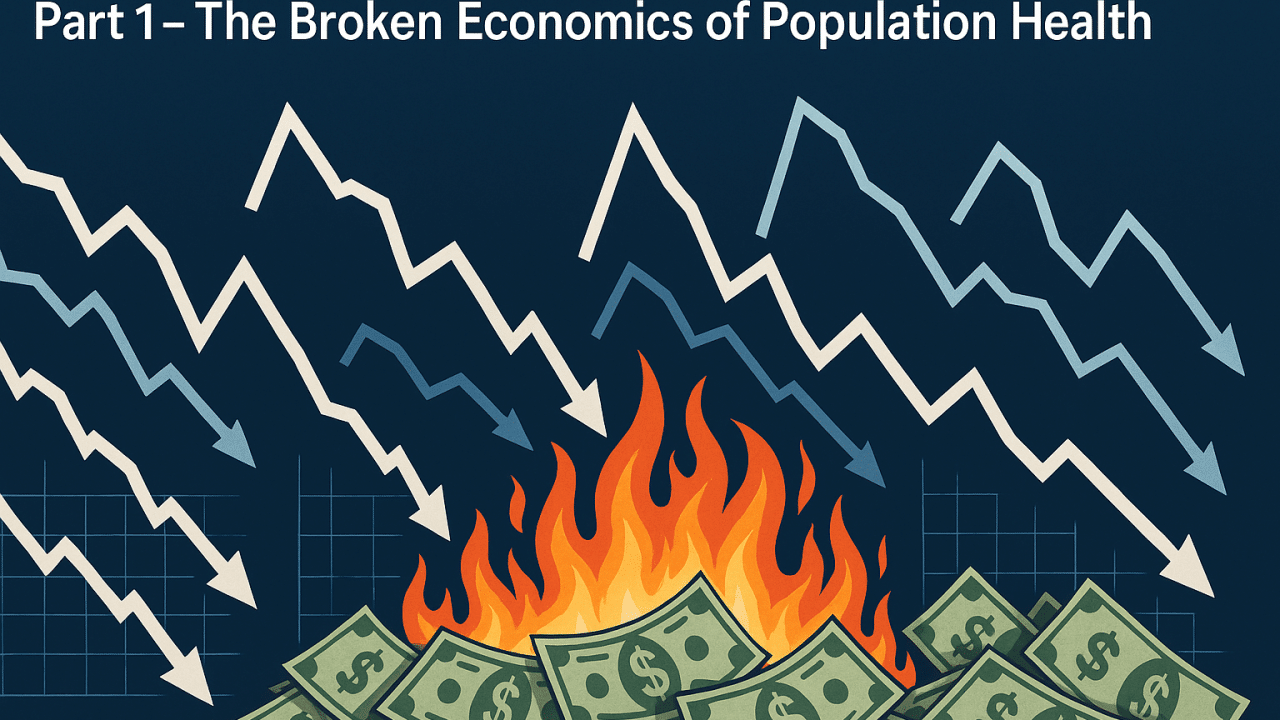
𝙋𝙖𝙧𝙩 1 — 𝙏𝙝𝙚 𝘽𝙧𝙤𝙠𝙚𝙣 𝙀𝙘𝙤𝙣𝙤𝙢𝙞𝙘𝙨 𝙤𝙛 𝙋𝙤𝙥𝙪𝙡𝙖𝙩𝙞𝙤𝙣 𝙃𝙚𝙖𝙡𝙩𝙝 (𝙖𝙣𝙙 𝙒𝙝𝙮 𝘾𝙝𝙖𝙨𝙞𝙣𝙜 𝘿𝙚𝙢𝙖𝙣𝙙 𝙃𝙖𝙨 𝙇𝙚𝙙 𝙩𝙤 𝙈𝙖𝙧𝙜𝙞𝙣 𝙀𝙧𝙤𝙨𝙞𝙤𝙣)
For more than a decade, population health management has been the rallying cry of U.S. healthcare. Health plans, providers, and consultants promised that better care coordination, care gap closure, and value-based care programs would finally bend the cost curve. Billions of dollars were poured into care management platforms, member engagement apps, and utilization management programs.
And yet, the numbers tell a different story:
• Administrative costs for commercial health plans remain in the 12–15% range, while traditional Medicare runs at ~2%.
• Medical Loss Ratios (MLR) in Medicare Advantage and Medicaid managed care continue to fluctuate under pressure, forcing payers to chase Stars Ratings, Quality Bonus Payments (QBP), and risk adjustment revenue just to maintain margins.
The uncomfortable truth: what we’ve called “population health economics” has really been demand-side economics in disguise.
𝙒𝙝𝙮 𝘿𝙚𝙢𝙖𝙣𝙙–𝙎𝙞𝙙𝙚 𝙏𝙝𝙞𝙣𝙠𝙞𝙣𝙜 𝙁𝙖𝙞𝙡𝙨
Demand-side economics in healthcare looks like this:
• Waiting for claims data (180-day lag) to identify risk.
• Suppressing demand with narrow networks and high deductibles.
• Rationing utilization through prior authorization and denials.
• Obsessing over gap closure as the pathway to quality scores.
This creates an illusion of control but it doesn’t scale. Instead, it produces margin erosion:
• Every care gap closed reopens again next year.
• Utilization suppression backfires as members delay care and return sicker, costlier, and angrier.
• Care management programs collapse under workforce strain, with case managers overloaded and burnout rising.
• Tech point-solutions fail to bend MLR because they weren’t designed for systemic economics.
The result? Payers are stuck on a treadmill. Margins erode, member experience suffers, and executives keep paying consultants for strategies that only rearrange demand-side data.
𝗔 𝗣𝗼𝗹𝗮𝗿𝗶𝘇𝗶𝗻𝗴 𝗕𝘂𝘁 𝗡𝗲𝗰𝗲𝘀𝘀𝗮𝗿𝘆 𝗣𝗼𝗶𝗻𝘁
Here’s where this gets uncomfortable for many in the industry:
If you’ve been relying on claims-driven insights, retrospective care gap closure, or point-solution “engagement tools,” you haven’t been doing population health economics. 𝚈̲𝚘̲𝚞̲’̲𝚟̲𝚎̲ ̲𝚋̲𝚎̲𝚎̲𝚗̲ ̲𝚍̲𝚘̲𝚒̲𝚗̲𝚐̲ ̲𝚙̲𝚘̲𝚙̲𝚞̲𝚕̲𝚊̲𝚝̲𝚒̲𝚘̲𝚗̲ ̲𝚑̲𝚎̲𝚊̲𝚕̲𝚝̲𝚑̲ ̲𝚊̲𝚌̲𝚌̲𝚘̲𝚞̲𝚗̲𝚝̲𝚒̲𝚗̲𝚐̲.̲
That accounting has delivered no lasting margin stability, no reduction in avoidable utilization, and no real progress toward equity.
Medicare Advantage margins are under pressure not because CMS made the Stars cut harder, but because Stars themselves were never the real lever of population health economics.
Plans spent a decade engineering “gap-chasing” and quality performance infrastructure, only to discover that when CMS adjusted the scoring curve, the entire house of cards collapsed. Billions in admin and vendor spend, yet no durable economics.
This is the core failure of demand-side thinking: building systems to optimize scores instead of creating new inputs. When the scoring rubric shifts, demand-side economics implodes. Supply-side economics doesn’t depend on CMS formulas it generates continuous, member-driven risk data that stabilizes MLR whether Stars are up, down, or rewritten.
Health plans were never built as supply-side engines.
• They don’t deliver care — they administer access.
• They don’t generate new inputs — they ration existing ones.
• They don’t create visibility — they price networks and report lagging claims.
That’s why supply-side economics has escaped them. It never fit their operating model. Instead, they built a decade of infrastructure around demand-side levers: utilization controls, Stars gap-chasing, risk adjustment coding.
And when CMS shifted the Star Ratings curve, the whole façade cracked. Billions in administrative spend collapsed into a hamster wheel that never produced durable economics.
But here’s the real pivot: supply-side economics doesn’t ignore CMS rubrics. It renders them irrelevant as constraints because when you generate a continuous supply of member-driven risk data, you always have the inputs to dominate any scoring system Washington creates, today or tomorrow.
That’s the difference: demand-side plans try to “game” CMS rules. Supply-side plans set themselves up to win no matter how the rules change.
Demand-side tools don’t solve the problem they only document it.
𝗧𝗵𝗲 𝗦𝗵𝗶𝗳𝘁 𝗔𝗵𝗲𝗮𝗱
If the last decade of “population health management” has proven anything, it’s this:
• You can’t close your way to profitability.
• You can’t suppress your way to sustainability.
• And you can’t consult your way into new data supply.
The broken economics of population health is the failure to recognize that no amount of demand-side tinkering can stabilize payer margins. What’s needed is a supply-side engine a scalable, continuous stream of real-time risk data that creates new inputs into the system.
Part 1 of 10.

MyRoad.io provides Targeted, Relevant, and Timely Data. Schedule a consultation to integrate into your sales funnel.

